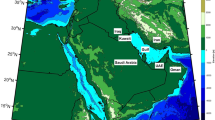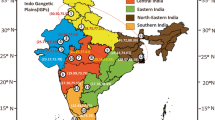Abstract
The extremely low value of the Northern Hemisphere annular mode (NAM) that occurred in the winter of 2009/2010 led to rare extreme low temperatures and heavy snow disasters over Northeast China. Studies on the effect of NAM on temperature often rely on correlation analysis, synthetic analysis, regression analysis, and other statistical methods. However, although the statistical method is instructive to the discussion of physical mechanisms, it cannot prove whether there is causality between variables. Here, we apply extended convergent cross mapping (ECCM) to detect the time-delayed causal interaction between NAM and winter surface air temperature (SAT) over Northeast China. Results indicate that the winter SAT information is encoded in the contemporaneous 1000 hPa NAM and vice versa, showing the contemporaneous bidirectional causality between them. In addition, we detected a unidirectional causality between 500 hPa NAM and winter SAT. NAM at 500 hPa can influence the SAT but not vice versa. Moreover, we examine the time-delayed causality between winter SAT and the stratospheric NAM at 50 hPa. Stratospheric NAM can influence the SAT approximately 10 days later. These causal relationships and feedback effects in dynamic systems have opened up the possibility of improving the prediction of winter SAT over Northeast China by using the NAM as an external factor.






Similar content being viewed by others
Data availability
All data needed to evaluate the conclusions in the paper are present in the paper.
Code availability
All codes related to this paper may be requested from the corresponding author.
References
Baldwin MP, Dunkerton TJ (2001) Stratospheric harbingers of anomalous weather regimes. Science 294:581–584
Cattiaux J, Vautard R, Cassou C et al (2015) Winter 2010 in Europe: a cold extreme in a warming climate. Geophys Res Lett 37(20):114–122
Chen HB, Fan XH (2011) Some extreme events of weather, climate and related phenomena in 2010. Clim Environ Res 16(60):789–804
Deyle ER, Sugihara G (2011) Generalized theorems for nonlinear state space reconstruction. PLos ONE 6(3):e18295
Deyle ER, May RM, Munch SB, Sugihara G (2016) Tracking and forecasting ecosystem interactions in real time. Pro R Soc B 283:20152258
Ding DP, Zhang AP, Han C et al (2010) Analysis of the low temperature and heavy snowfall events in November 2009 in Beijing. Clim Environ Res 15(4):395–404
Gong DY, Wang SW (1999) Definition of Antarctic oscillation index. Geophys Res Lett 26(4):459–462
Granger GW (1969) Investigating and relations by econometric models and cross-spectral method. Econ J Econ Soc 37(3):424–438
Kutzbach J (1951) Large-Scale and irregular variations of the Northern Hemisphere anomaly maps of sea-level pressure profile. Meteorol 8:52–59
Li L, Li CY, Song J (2012) Arctic Oscillation anomaly in winter 2009/2010 and its impacts on weather and climate. Sci China Earth Sci 55:567–579
Li YS, Yu M, Zhang J (2010) Diagnostic Analysis of temperature anomaly in Heilongjiang Province in winter 2009. Heilongjiang Meteorol 027(003):4–7
Lorenz EN (1951) Seasonal and irregular variations of the Northern Hemisphere sea-level pressure profile. J Atmos Sci 8(1):52–59
Ma H, Leng S, Chen L (2018) Data-based prediction and causality inference of nonlinear dynamics. Sci China Math 61(2):403–420
Myers JL, Well A (2003) Looking at data: relations between quantitative variables. In: Research Design and Statistical Analysis, Chapter 3. 2nd ed. Mahwah, NJ: Taylar & Francis: 47–67
Packard NH, Crutchfield JP, Farmer JD et al (1980) Geometry from a time series. Phys Rev Lett 45(9):712–715
Sugihara G, May RM, Ye H et al (2012) Detecting causality in complex ecosystems. Science 338(6106):496–500
Sun C, Li JP (2012) Analysis of anomalously low surface air temperature in the Northern Hemisphere during 2009/2010 winter. Climatic and Environmental Research 17(3):259–273
Takens F (1981) Detecting strange attractors in turbulence[M]. Dynamical systems and Turbulence, Springer-Verlag, New York, pp. 366–381
Tsonis AA, Deyle ER, May RM et al (2015) Dynamical evidence for causality between galactic cosmic rays and interannual variation in global temperature. Proc Natl Acad Sci USA 112(11):3253
Wallace JM, Gutzler DS (1981) Teleconnection in the geopotential height field during the Northern Hemisphere winter. Mon Weather Rev 109(4):784–812
Wan XM, Fu Z, Hu YY (2013) The influence of stratospheric anomalies on the northeast cold vortex. Acta Scientiarum Nat Univ Pekinesis 49(3):417–425
Xu GY (2011) Variation of extreme cold events in Beijing during the winter from 1951 to 2009. Meteorol Environ Sci 34(1):23–26
Yang YM, Zhao R (2013) Comparative analysis of two snowstorms in Heilongjiang Province in winter of 2019. Heilongjiang Meteorol 30(4):21–23
Ye H, Deyle ER, Gilarranz LJ et al (2015) Distinguishing time-delayed causal interactions using convergent cross mapping. Sci Rep 5:14750
Yu Z, Zhou HF, Sun JC (2011) Analysis of cause and radar echo characteristics of large-scale snowstorm in North China in 2009. Shandong Meteorol 31(4):12–18
Acknowledgements
We acknowledge the daily/monthly reanalysis data from the National Center for Environmental Prediction/National Center for Atmospheric Research (NCEP/NCAR).
Funding
This research was supported by the National Natural Science Foundation of China (42075054 and 41575058).
Author information
Authors and Affiliations
Contributions
Nannan Zhang and Geli Wang designed this study and contributed to the preparation and writing of the manuscript.
Corresponding author
Ethics declarations
Ethics approval
Not applicable.
Consent to participate
Not applicable.
Consent for publication
Not applicable.
Conflict of interest
The authors declare no competing interests.
Additional information
Publisher's note
Springer Nature remains neutral with regard to jurisdictional claims in published maps and institutional affiliations.
Rights and permissions
About this article
Cite this article
Zhang, N., Wang, G. Detecting time-delayed causal interaction between Northern Hemisphere annular mode and winter surface air temperature over Northeast China: a case study of 2009/2010 winter. Theor Appl Climatol 146, 1249–1256 (2021). https://doi.org/10.1007/s00704-021-03793-9
Received:
Accepted:
Published:
Issue Date:
DOI: https://doi.org/10.1007/s00704-021-03793-9




